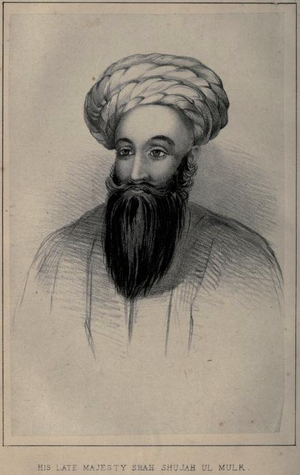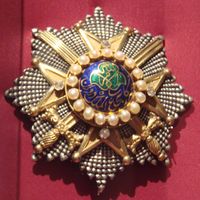شجاع شاه الدراني
| شجاع شاه الدراني | |||||
|---|---|---|---|---|---|
| أمير أفغانستان | |||||
 اسكتش قديم يصور الشاه شجاع الملك | |||||
| أمير أفغانستان | |||||
| العهد | 1803–1809 1839–1842 | ||||
| تتويج | 13 يوليو 1803 | ||||
| سبقه | محمود شاه الدراني | ||||
| تبعه | دوست محمد خان | ||||
| وُلِد | 4 نوفمبر 1785 | ||||
| توفي | 5 أبريل 1842 | ||||
| الزوجات |
| ||||
| |||||
| الأسرة المالكة | الأسرة الدرانية | ||||
| الأب | تيمور شاه الدراني | ||||
شجاع شاه دراني (ويُعرف أيضاً بالأسماء شاه شجاعʻ، شجاع شاه، شجاع الملك) (حوالي 4 نوفمبر 1785 – 5 أبريل 1842) كان حاكم دولة دراني من سنة 1803 حتى 1809. ثم حكم من 1839 حتى وفاته في 1842. وكان شجاع شاه من خط Sadozai في جماعة أبدالي من الپشتون. وقد أصبح خامس أمراء أفغانستان.[1]
الهيئة
According to Mountstuart Elphinstone, "The King of Kabul [Shah Shuja] was a handsome man". He also wrote "of an olive complexion with a thick black beard.....his voice clear, his address princely." Shuja wore the Koh-i-Noor diamond in one of his bracelets when Elphinstone visited him.[2] William Fraser, who accompanied Elphinstone was "struck with the dignity [Shah Shuja] of his appearance and the romantic Oriental awe..."[3] Fraser also "judged" him to be "about five feet six inches tall" and his skin colour was "very fair, but dead...his beard was thich jet black and shortened a little by the obliquely upwards, but turned again at the corners....The eyelashes and the edges of his eyelids were blackened with antimony" He also described Shuja's voice as "loud and sonorous".[4]
زيجاته
After coming to power in 1803, Shuja ended the "blood feud" with the Barakzais and also forgave them. To create an alliance with them, he married "their sister" Wa'fa Begum.[5]
حياته العملية
اطاحات وسجن وتحالفات
Shuja Shah was the governor of Herat and Peshawar from 1798 to 1801. He proclaimed himself as King of Afghanistan in October 1801 (after the deposition of his brother Zaman Shah), but only properly ascended to the throne on July 13, 1803.
Shuja allied Afghanistan with the United Kingdom in 1809, as a means of defending against an invasion of Afghanistan and India by Russia.[6]
In June, 1809,[7] he was overthrown by his predecessor Mahmud Shah and went into exile in India, where he was captured by Jahandad Khan Bamizai and imprisoned at Attock (1811–2) and then taken to Kashmir (1812–3) by Atta Muhammad Khan. When Mahmud Shah's vizier Fateh Khan invaded Kashmir alongside Maharaja Ranjit Singh's army, he chose to leave with the Sikh army. He stayed in Lahore from 1813 to 1814. In return for his freedom, he handed the Koh-i-Nor diamond to Maharaja Ranjit Singh and gained his freedom. He stayed first in Punjab and later in Ludhiana with Shah Zaman. The place where he stayed in Ludhiana is presently occupied by Main Post Office near Mata Rani Chowk and a white marble stone inside the building marking his stay there can be seen.
In 1833 he struck a deal with Maharaja Ranjit Singh of the Punjab: He was allowed to march his troops through Punjab, and in return he would cede Peshawar to the Sikhs if they could manage to take it. In a concerted campaign the following year, Shuja marched on Kandahar while the Sikhs, commanded by General Hari Singh Nalwa attacked Peshawar. In July, Shuja Shah was narrowly defeated at Kandahar by the Afghans under Dost Mohammad Khan and fled. The Sikhs on their part reclaimed Peshawar.
In 1838 he had gained the support of the British and the Sikh Maharaja Ranjit Singh for wresting power from Dost Mohammad Khan Barakzai. This triggered the First Anglo-Afghan War (1838–1842). Shuja was restored to the throne by the British on August 7, 1839,[8] 30 years after his deposition, but did not remain in power when the British left. He was assassinated by Shuja ud-Daula, on April 5, 1842.[9]
الهامش
- ^ Encyclopædia Britannica – Shah Shoja
- ^ Dalrymple 2012, p. 18.
- ^ Dalrymple 2012, p. 20.
- ^ Dalrymple 2012, p. 21.
- ^ Dalrymple 2012, p. 23.
- ^ Dalrymple 2012, p. 5.
- ^ Dalrymple 2012, p. 27.
- ^ Moon, P. (1989). The British Conquest and Dominion of India, London: Duckworth, ISBN 0-7156-2169-6, p.515
- ^ Moon, P. (1989). The British Conquest and Dominion of India, London: Duckworth, ISBN 0-7156-2169-6, p.552
مصادر
- Dalrymple, William (2012). Return of a King: The Battle for Afghanistan. Bloomsbury. ISBN 978-1-408-8183-05.
للاستزادة
- ديوان شجاع (1825)
- مذكرات شجاع الملوك شاه، ملك أفغانستان (1826)
وصلات خارجية
- Encyclopædia Britannica – Shah Shoja
- The British Library – Afghanistan 1809-1838: Sources in the India Office Records
| ألقاب ملكية | ||
|---|---|---|
| سبقه محمود شاه |
أمير أفغانستان 1803–1809 |
تبعه محمود شاه |
| سبقه دوست محمد خان |
أمير أفغانستان 1839–1842 |
تبعه أكبر خان |

